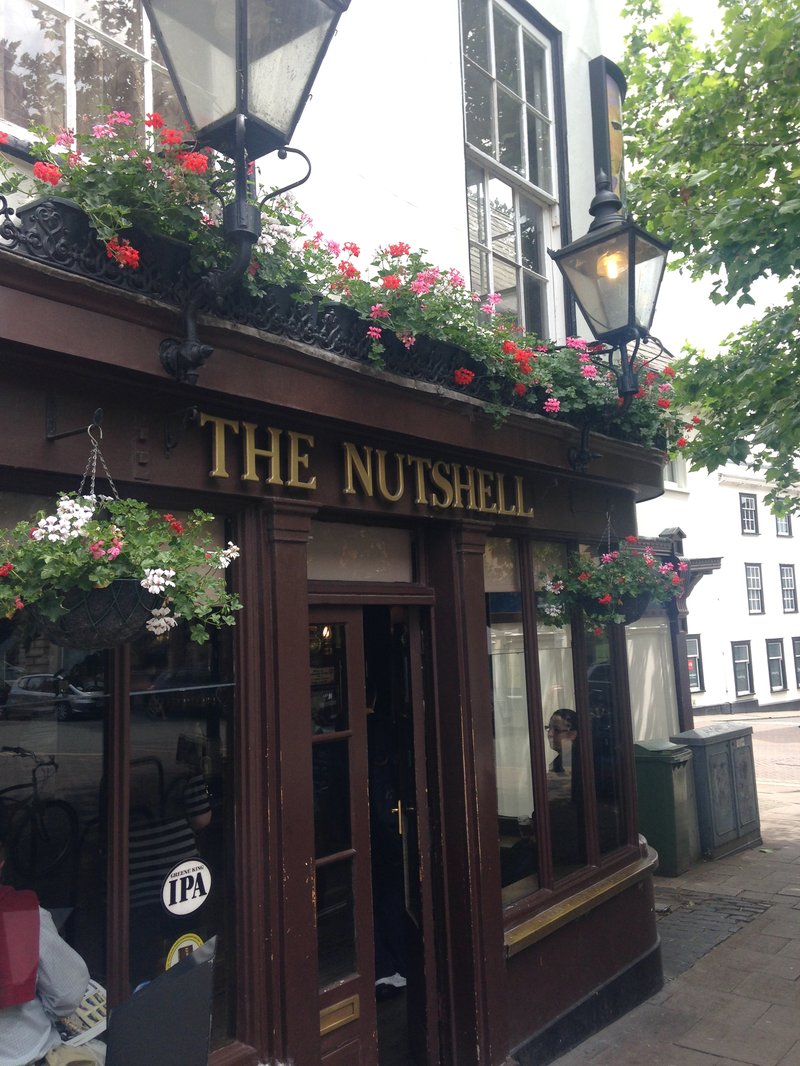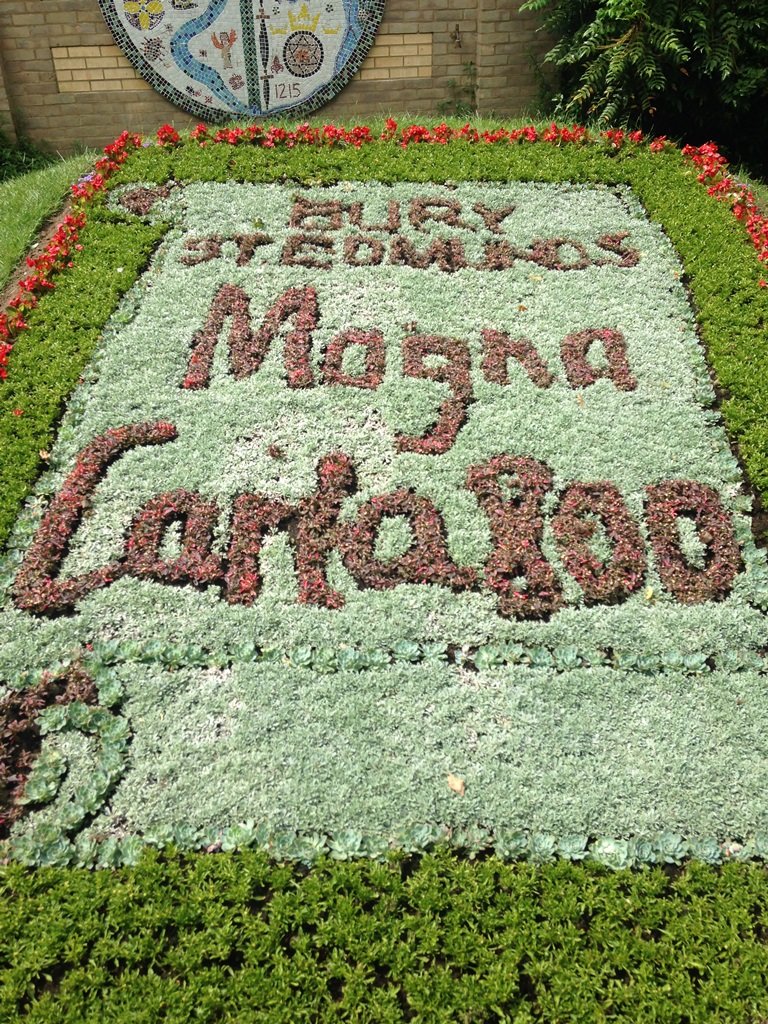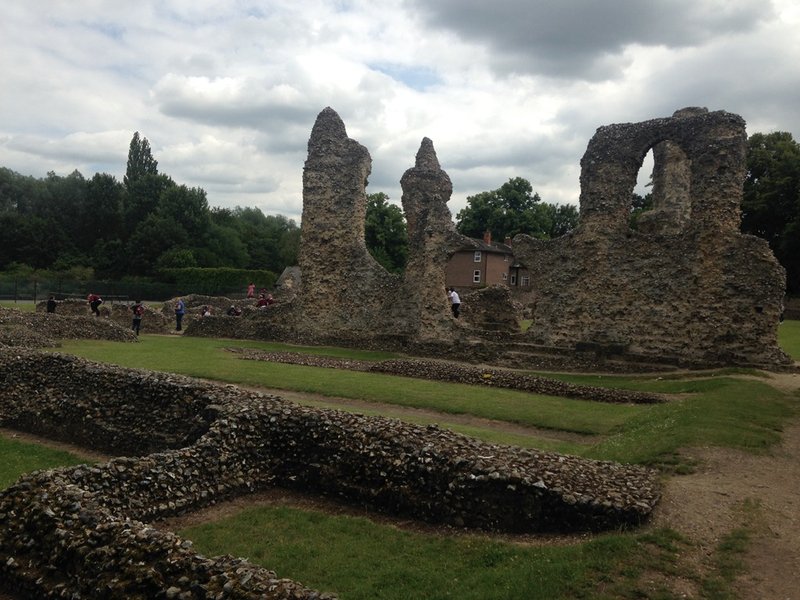Bury St Edmunds: A natural home for pageantry
I’ve spent most of this week in the picturesque town of Bury St Edmund’s, Suffolk, carrying out archival research and meeting up with Alan Baxter, who represents Magna Carta 800 – one of our official project partners. I have, of course, also found plenty of time to wander around the extensive and beautifully conserved ruins of the medieval Abbey, and even to savour a pint in (officially!) the smallest bar in the UK – the Nutshell.
Bury St Edmunds is a town visually and emotionally defined, in many respects, by its long history. Two events more than any others dominate the representation of its past. Firstly, the martyrdom of King Edmund in 870 A.D., from which the town takes its name. Slayed by marauding Danish hordes, the folk tale of his disembodied head being guarded by a lone wolf is featured on the towns crest. Secondly, the possible local meeting of Barons in 1214, the year before the Magna Carta was signed in Runnymede. Disguised as pilgrims, they allegedly took a collective oath at the altar of the Abbey, promising to force King John to seal the Great Charter. The towns motto expresses the importance of these events: ‘Sacrarium Regis, Cunanbula Legis’ - ‘Shrine of the King, Cradle of the Law’.
Events like these, of course, lend themselves well to historical pageantry. Small towns like Bury St Edmunds, with a population of around 16,000 at the start of the twentieth century, could nonetheless make a strong case for having been the site of nationally important events. Tracing the present-day structures of law and order from small local beginnings centuries before, they claimed a patriotic place in the culture of the country. Unsurprisingly then the Abbey Gardens have been the site of three large pageants. First, in 1907 during the initial wave of ‘pageant fever’, the father of historical pageantry himself, Louis Napoleon Parker, directed the Bury St Edmund’s Pageant. Next, in 1959, was the Bury St Edmunds Pageant of Magna Carta, the first event held as part of the tricentennial celebrations of that momentous event, supported by the Magna Carta Trust. Finally, in 1970, the pageant-play Edmund of Anglia, held to commemorate the 1100 years since his death. All of these stagings depended on an enthusiastic public, who volunteered their talents not just in performing the scenes but also in producing costumes and properties. Reported in both the local and national press, they brought the town into stark public visibility.
In the archives and the heritage collections of the town there is a wealth of material relating to the pageants. As with most of the events we look at, there are a range of postcards and photos, to go alongside the original scripts and Books of Words. More unique however is the extent of the surviving props, like daggers and swords, and commemorative items, like china plates and silver inkwells. There are also detailed plans relating to the production of the pageant - like sketches of costume design and architectural drawings of the stage and the Edmund shrine. Even more exciting is the extensive filmed coverage of all three of the pageants – some narrated, with a suitably plummy BBC voice, and the latest even in colour.
As part of our partnership with Magna Carta 800 - who tweet here - we are hoping to use these materials to deepen our understanding of these three pageants, giving them the scholarly attention they deserve. Massively popular, with lasting ramifications for public memory in the town, they remain woefully understudied. Our overarching aim however is to bring these pageants to the public. As the final two pageants were staged fairly recently (at least in historical terms!) we are going to be recording oral history interviews with participants and spectators during the pageants. It is likely that this will start to take place at the end of this summer; keep tuned for more information and, in the meantime, please do get in touch if you or someone you know was involved in either the 1959 or 1970 event in any way at all. Next year we also plan to stage an exhibition in the town, with associated public talks, to present some of the wonderful artefacts and stories came from the pageant. From swords and ceremonial cigarette cases to tales of alternative protest pageants, the complexity of these three events will be presented for all to see. At the same time we will be frequently blogging about Bury St Edmund’s and its pageants, and keeping you updated on the progression of the exhibition and oral history plans.
Watch this space!



